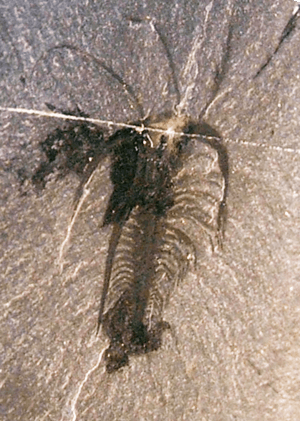Marrella facts for kids
Quick facts for kids Marrella splendens |
|
|---|---|
 |
|
| Fossil Marrella | |
| Scientific classification | |
| Kingdom: | |
| Phylum: | |
| Class: |
Marrellomorpha
|
| Order: |
Marrellida
|
| Family: |
Marrellidae
Walcott, 1912
|
| Genus: |
Marrella
Walcott, 1912
|
| Species: |
M. splendens
|
| Binomial name | |
| Marrella splendens Walcott, 1912
|
|
Marrella splendens was a small, ancient sea creature that lived a very long time ago, during the Cambrian period. It's a type of arthropod, which is a group of animals that includes insects, spiders, and crabs. Scientists have found many fossils of Marrella splendens in a famous fossil site called the Burgess Shale in British Columbia, Canada. In fact, it's the most common animal found there!
Contents
Discovery of Marrella Fossils
Marrella splendens was the very first fossil found by a scientist named Charles Doolittle Walcott in the Burgess Shale. He discovered it in 1909. Walcott was exploring the mountains in British Columbia when he stumbled upon this amazing fossil site.
When Walcott first saw Marrella, he informally called it a "lace crab" because of its delicate, lace-like appearance. Later, he thought it might be a strange type of trilobite, which were common ancient sea creatures.
What Makes Marrella Unique?
Many years later, in 1971, another scientist named Harry B. Whittington took a much closer look at Marrella. He studied its legs, gills, and the parts around its head very carefully.
Whittington realized that Marrella was not a trilobite at all. It also wasn't a chelicerate (like spiders or scorpions) or a crustacean (like crabs or lobsters). Marrella was truly unique and belonged to its own special group of arthropods.
Where Else Are Marrella Fossils Found?
While most Marrella fossils come from the Burgess Shale, similar creatures have been found in other ancient rock layers from the Cambrian period. This shows that Marrella-like animals lived in different parts of the ancient oceans. Some fossils of these relatives have even been found in rocks as recent as the Devonian period, which was millions of years after the Cambrian.
Images for kids
-
Life reconstruction of Marrella by the MUSE - Science Museum, in Trento
See also
 In Spanish: Marrella para niños
In Spanish: Marrella para niños


